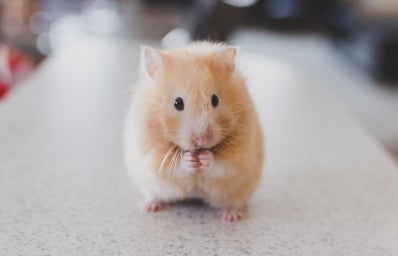At the beginning of quarantine, my girlfriend and I decided it was the best time to get a hamster. We would be home more often to care for him, and he would be another companion to have while we were stuck inside away from family and friends. First, of course, we did a bunch of research on what to feed him, what kind of wheel to get, what bedding to use, and any other necessities he may need that we did not know. This research continued even after we bought him, as we wanted to ensure our baby hamster, who we named Apple, would live his best life! Unfortunately, there are many misconceptions out there on hamster care, so I needed to take a deeper dive into the Internet to investigate the needs of my pet. Here are some of the most essential tips and facts to know before you consider buying your hamster.
- Hamsters are nocturnal!
-
It surprises me how many people do not know this about hamsters. You cannot buy a hamster and expect him or her to be up all day, running on their wheel and playing with you. Hamsters are nocturnal – they sleep during the day and come out at night. If you want a pet that you can see all the time and interact with during midday, maybe a hamster is not for you. Now, this does not mean you never get to see your hamster; some of them wake up as early as 7 p.m., others make trips above ground during daylight hours for food and water, yet some of them, like mine, do not come out until past midnight. I found that the time they wake up heavily depends on the time you go to be, or the time you turn all the lights out. Though, do your best to not wake up your pet during the day. How would you feel if someone woke you up in the middle of the night? Probably grumpy. Hamsters have their schedules, which are quite the opposite of a human’s, and it is best to let them be. The key idea here is to not invest in a hamster as your pet without considering this. There are plenty of other small animal pets who are not nocturnal!
- Find the right cage!
-
One thing I was surprised to find out while buying my hamster was that the cages often promoted in the hamster aisle at the pet store are not good for your pet. These infamous cages with brightly-colored wiring and plastic tubes shooting in and out of them are harmful for most small animal pets. Ultimately, these cages are just too small. Hamsters need approximately 450 square inches of floor space, and these colorful cages come nowhere close to that. Additionally, the wiring is not at all a benefit for your hamster. Despite much outdated and simply inaccurate information out there, hamsters do not like to climb. Hamsters burrow. If your hamster is climbing on the bars of its cage, it is not so likely that they are doing so for fun; rather, they are trying to escape, most likely because the cage is inadequate. This climbing can cause an injury if they were to fall from these bars! Furthermore, owners with these cages usually report their pets chewing on the bars; this is a behavior that signals boredom as well as possible neglect. Hamsters need more space than these cramped cages permit. These over-advertised cages typically allow for as little height as one or two inches of bedding. Hamsters require at least three.
So what is the alternative to such a terrible home? A tank! I own a 55 gallon tank meant for reptiles or fish for my dwarf hamster, which allows for almost 700 square inches of floor space as well as a very large amount of bedding, sometimes even reaching a foot high. Hamsters need plenty of exercise, and they love to burrow, which is why you should consider investing in a tank that allows plenty of space for these activities.
Side note: Hamsters are solitary animals – more than one hamster should never be kept in the same cage as this can generate violence.
- Be aware of your hamster’s needs!
-
Plenty of hamster merchandise placed in pet stores and sold online can be harmful, so it is crucial to do your research and know what products are safe for your little pet. For instance, many beddings are made from wood shavings but take note that aspen is good for your hamster, while cedar and the dust produced from it can cause breathing issues. With my hamster, I have noticed that he prefers softer bedding.
Another need is chewing; these are essential for the health of your hamster’s teeth. Since their teeth are consistently growing, they need something to gnaw on that is healthy for them (not the bars of cages). Like bedding, there is a surplus of options for hamster chews; wooden chews are common, but my hamster showed a significant preference for edible chews like his cheese chew.
Then, of course, there is the wheel, which should always be in your hamster’s home, as it is their main source of exercise, which hamsters need lots of to get all of that energy out. It is more than disheartening to see that some stores still carry wheels made of wire mesh; this type of wheel can hurt your pet! Their little toes can get stuck in the holes while running. Never buy one like this. Instead, invest in a wheel like a Silent Runner or a flying saucer, as I have; these are much safer for your pet. Additionally, make sure this exercise equipment is large enough for your hamster, or else the curve of the wheel can cause back problems over time!
Another need is chews; these are essential for the health of your hamster’s teeth. Since their teeth are constantly growing, they need something to gnaw on that is healthy for them (not the bars of cages). Like bedding, there is a surplus of options for hamster chews; wooden chews are common, but my hamster has shown a significant preference for edible chews, like his cheese chew.
Then, of course, there is the wheel, which should always be in your hamster’s home, as it is their main source of exercise… and hamsters need lots of exercise to get all of that energy out. It is more than disheartening to see that some stores still carry wheels made of wire mesh; this type of wheel can hurt your pet! Their little toes can get stuck in the holes while running. Never buy one like this. Instead, invest in a wheel like a Silent Runner or a flying saucer, like I have; these are much safer for your pet. Additionally, make sure this exercise equipment is large enough for your hamster, or else the curve of the wheel can cause back problems over time!
- Hamster balls are no good!
-
I was surprised to find that the iconic hamster balls can be harmful to your pet, since their little fingers and toes can get stuck in the tiny holes in the ball, just like a wire mesh wheel. People argue that hamsters like these plastic balls because of the way they run around so “eagerly” in them. However, this may be due to anxiety, as they are trying to find a way out of the situation. Because of this counterargument, I opted for a playpen rather than a ball. Admittedly, my hamster is not very fond of the playpen setup; he seems to get anxious when he is in any environment other than the safety of his luxurious, bedding-filled home. However, I have seen this option work well for others!
- Hamsters are prone to diabetes!
-
This medical condition is such an important fact to note before buying a hamster since correctly feeding them is one of the most important tasks as their caretaker. First, buying the right food is essential – this usually includes a wide variety of nuts and seeds for them to pick and choose from. Then comes the issue of treats; I will be the first to admit that one of the most exciting things about having a pet is being able to spoil them! However, it is important to do this the right way: in moderation. My hamster loves treats (who doesn’t?), but I try to give him these periodically. Although, the frequency of treat-giving depends on the treat. With more sugary treats, I try to limit these to once a week, sometimes even less. On the other hand, I give him healthier treats like a small piece of red pepper or a shred of kale two to three times a week! Lastly, make sure that your tiny pet has access to freshwater and food every day, along with their chews!

This list by no means contains all the information you need, so do as much research as you can and be sure to gather tips from a multitude of sources – this will allow you to weed out the incorrect information. I suggest Munchie’s Place and Victoria Raechel on YouTube for the best info! Just because hamsters are small does not mean they do not require a lot of attention and care. Make sure to do your research before taking on the role of caretaker to a small animal. Lots of thought and planning goes into owning any type of pet, even one as tiny as a hamster!



